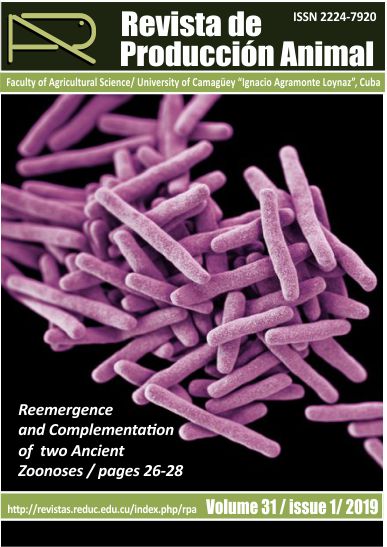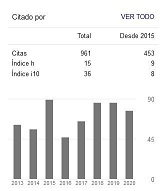Molluscicide Effect of Sapindus saponaria Fruit on Galba cubensis, an Intermediate Host of Fasciolosis in Cuba
Resumen
Galba cubensis is the main intermediate host of Fasciola hepatica in Cuba. The aim of this paper was to demonstrate the molluscicide effect of Sapindus saponaria L. on Galba cubensis in laboratory conditions, in order to recommend this plant for ecological control of this snail. Different concentrations of the hydroalcoholic extract of six-month old S. saponaria pericarp were tested on G. cubensis individuals, based on the methodology of the World Health Organization. The concentration gradient was used to determine LC50 and LC90, which then were tested to estimate the heartbeat frequency of these mollusks. The molluscicide effect of the plant extract was considerable (P≤0.01; R2=60.6), with concentration-dependent mortality and a drop of heartbeat frequency. Significant differences were observed between LC50=39.8 mg/L and LC90=67.9mg/L, in the test to lower heartbeat frequency (P≤0.01), and between LC90 and the control group (P≤0.01), but not between the control group and LC50 and (P=0.24). Molluscicide activity in the plant material was still present after six months of application, which was an important fact to recommend this plant as a candidate to control intermediate hosts of Fasciolosis in our region.
Descargas
Citas
ABREU, O. (2005). Potencial medicinal del género Sapindus L. (Sapindaceae) y de la especie Sapindus saponaria L. Rev Cubana Plant. Med., 10 (3-4), 45-50.
AMUNARRIZ, M. (1991). Intermediated hosts of Paragonimus in the Easter Amazonic Region of Ecuador. Trop. Med. Parasitology, 42 (3), 164-166.
CHAIEB, I. (2013). Novel Advances and Perspectives to Use of Plant Saponins as Pesticides. Acta Horticulturae, 97 (21), 177-184.
DA SILVA, C.; VARGAS, T. S.; BAPTISTA, D. F. (2013). Molluscicidal activity of Moringa oleifera on Biomphalaria glabrata: integrated dynamics to the control of the snail host of Schistosoma mansoni. Rev Bras Farmacogn, 23 (5), 848-850.
DESHMANE, J.; NANAWARE, S. G. (2011). The Effects of Plant Toxin from Fruit Extract of Sapindus laurifolius on Mortality of Fresh Water Snail, Bellamya bengalensis (Lamarck). Biological Forum – An International Journal, 3 (2), 48-51.
DÍAZ, R.; FERRER, J. R. (1996). Efecto de las dosis letales de plantas molusquicidas de la familia Agavacea sobre la actividad cardiaca y la ovoposición de Biomphalaria havanensis (Mollusca: Planorbidae). Rev Cubana Med Trop., 48 (1), 15-20.
FLECHAS, H. A.; ARAGÓN, C., MORALES, N. B.; JIMÉNEZ, P. J. A. (2009). Investigación y desarrollo de tres productos del jaboncillo (Sapindus saponaria L.) como base para la industrialización. Colombia Forestal, 12 (1), 171-182.
GOYAL, S.; KUMAR, D.; MENARIA, G.; Singla, S. (2014). Medicinal Plants of the Genus Sapindus (Sapindaceae) a Review of their Botany, Phytochemistry, Biological Activity and Traditional Uses. J Drug Del Ther., 4 (5), 7-20.
HEVIA, Y.; SÁNCHEZ, J.; TACORONTE, J. E.; GUTIÉRREZ, A.; VÁZQUEZ, A. A.; WONG, L.; TIOMNOVA, O. T. (2009). Efecto de la colofonia sobre la actividad cardiaca y eclosión de los huevos de Biomphalaria havanensis. Rev Cubana Med Trop.; 61 (3), 244-247.
HUANG, H. C.; LIAO, S. C.; CHANG, F.C; KUO, Y. H.; WU, Y. C. (2003). Molluscicidal saponins from Sapindus mukorrossi, inhibitory agents of golden apple snails, Pomacea caniculata. J. Agric. Food. Chem., 51 (17), 4916-4919.
IANNACONE, J.; LA TORRE, M. I.; ALAVARIÑO, L.; CEPEDA, C.; AYALA, H.; ARGOTA, G. (2013). Toxicidad de los bioplaguicidas Agave americana, Furcraea andina (Asparagaceae) y Sapindus saponaria (Sapindaceae) sobre el caracol invasor Melanoides tuberculata (Thiaridae). Neotropical Helmintology, 7 (2), 231-241.
KHAN, M. K.; SAJID, M. S.; RIAZ, H.; AHMAD, N. E.; HE, L.; SHAHZAD, M. et al. (2013). The Global Burden of Fasciolosis in Domestic Animals with an Outlook on the Contribution of New Approaches for Diagnosis and Control. Parasitol Res.; 112 (7), 2421-2430.
KIROS, G.; ERKO, G.; GIDAY, M.; MEKONNEN, Y. (2014). Laboratory Assessment of Molluscicidal and Cercariacidal Effects of Glinus lotoides Fruits. BMC Research Notes, 7 (1), 220.
KNOPP, S.; MOHAMMED, K. A.; ALI, S. M.; KHAMIS, I. S.; AME, S. M.; ALBONICO, M. et al. (2012). Study and Im-plementation of Urogenital Schistosomiasis Elimination in Zanzibar (Inguja and Pemba Islands) using an Inte-grated Multidisciplinary Approach. BMC Public Health, 12 (1), 930-943.
LACAILLE_DUBOIS, A.; WAGNER, H. (1996). A Review of Biological and Pharmacological Activities of Saponins. Phytomedicine, 2 (4), 365-386.
LEMOS, T. L. G.; MENDES, A. L.; SOUSA M. P. (1992). New saponin from Sapindus saponaria. Fitoterapia, 63 (6), 515-517.
LEÓN, H.; ALAÍN, H. (1953). Flora de Cuba III. La Habana, Cuba: Museo de Historia Natural.
MALEK, E.; CHENG, T. (1974). Medical and Economic Malacology. London: Ed. Academic Press.
MARSTON, A.; HOSTETTMANN, K. (1985). Plant molluscicides. Phytochemistry, 24 (4), 639-652.
MCCULLOUGH, F. S. (1992). The role of mollusciciding in Schistosomiasis control. Geneva: World Health Organi-zation.
MOZLEY, A. (1939). Fresh-water Mollusca of the Tangayika Territory and the Zanzibar Protectorate, and their rela-tion to human schistosomiasis. Trans Roy Soc Edinburgh, 59 (3), 687-691.
MULEY, E. V. (1978). Biological and chemical control of snail vector Melania scabra (Gastropoda: Prosobranchia). Bull Zool Survey India, 1 (1), 1-6.
MURGU, M.; RODRÍGUEZ-FILHO, E. (2006). Dereplication of glycosides from Sapindus saponaria using liquid chro-matography-mass spectrometry. J. Braz. Chem. Soc., 17 (7), 1281-1290.
OJEWOLE, J. A. O. (2004). Indigenous plants and schistosomiasis control in South Africa: molluscicidal activity of some Zulu medicinal plants. BLACPMA, 3 (1), 8-22.
PALACIO, D.; BERTOT, J. A.; BELTRAO, M.; VÁZQUEZ, A.; IZQUIERDO, N.; ARENAL, A.; ARTEAGA, A. (2017). Com-portamiento estacional de Fasciola hepatica en bovinos sacrificados en el matadero Chacuba, Camagüey, Cu-ba. Rev prod anim., 29 (1), 31-36.
PERERA, G.; YONG, M.; RODRÍGUEZ, J.; GÁLVEZ D. (1983). Cuban endemic mollusks infected with Angiostrongylus cantonensis. Malcological Review, 16 (1-2), 97-98.
QUIJANO, M.; LARA, G.; RIERA-RUIZ, C.; BARRAGÁN, A.; MIRANDA, M.; MANZANO, P. (2016). Field evaluation of plants molluscicide against Pomacea canaliculata. Emirates J Food Agric., 28 (3), 224-226.
QUIJANO, M.; RIERA-RUIZ, C.; BARRAGÁN, A.; MIRANDA, M.; ORELLANA, T.; MANZANO, P. (2014). Molluscicidal activity of the aqueous extracts from Solanum mammosum L., Sapindus saponaria L. and Jatropha curcas L. against Pomacea caniculata. Emirates J. Food Agric., 26 (10), 871-877.
RAYMOND, M. (1985). Presentation d’un programme basic d’analyse log-probit micro-ordinateur. Cah ORSTOM ser. Ent Med et Parasitol., 23 (2), 117-121.
RIBEIRO, A.; ZANI, C. L.; ALVES, T. M. A.; MENDES, N. M.; HAMBURGUER, M.; HOSTETTMAN, K. (1995). Mollusci-cidal saponins from the pericarp of Sapindus saponaria. Int J Pharmacog., 33 (3), 177-180.
RODRÍGUEZ, R.; TORRADO, L.; RIVERO, T.; XAVIER, F. (2000). La fasciolasis hepática humana en Camagüey. 1999. Rev. Arch. Méd .de Camagüey., 4 (2), 22-29.
ROIG, J. T. (1974). Plantas medicinales, aromáticas o venenosas de Cuba. La Habana: Editorial Ciencia y Técnica.
ROLLINSON, D.; KNOPP, S.; LEVITZ, S.; STOTHARD, J. R.; TCHUENT, L. A.; GARBA, A.; 2013. Time to set the agenda for schistosomiasis elimination. Acta Tropica.; 128 (2), 423-440.
SÁNCHEZ, J. A.; SILVA, J. (2008). Estudio silvicultural de la especie Sapindus saponaria L. (Jaboncillo) como base para el aprovechamiento silvoindustrial. Colombia Forestal, 11 (1), 71-82.
SINGH, S. K.; YADAV, R. P.; SINGH, A. (2010). Molluscicides from some common medicinal plants of eastern Uttar Pradesh, India. J Appl Toxicol., 30 (1), 1-7.
SOLER, B.; SÁNCHEZ, E.; MÉNDEZ, G.; GARCÍA, M.; MIRANDA, M. (1992). Normas ramales. Medicamentos de ori-gen vegetal. La Habana, Cuba: MINSAP.
SUKUMARAN, D.; PARASHAR, B. D.; RAO, K. (2008). Evaluation of some plant molluscicides against a freshwater snail Lymnaea luteola, the vector of animal schistosomiasis. Pharm Biol., 40 (6), 450-455.
TORREALBA, J. F.; SCORZA, J. V.; SANABRIA, M. S.; VÁZQUEZ, A. D.; RAMOS, B.; RICCARDI, B., et al. (1953). Nota preliminar sobre la acción malaquisita del fruto de paraparo (Sapindus saponaria). Gaceta Medica Caracas, 61 (10-12), 299-307.
UPADHYAY, A.; SINGH, D. K. (2012). Pharmacological effects of Sapindus mukorossi. Rev Inst Med Trop de Sao Paulo, 54 (5), 273-280.
VÁZQUEZ, A. A.; SÁNCHEZ, J.; HEVIA, Y. (2009). Distribución y preferencia de hábitats en moluscos hospederos in-termediarios de Fasciola hepática en Cuba. Rev Cubana Med. Trop., 61 (3), 248-253.
VÁZQUEZ, R.; DIÉGUEZ, L.; DEL RISCO, U.; FIMIA, R.; VÁZQUEZ, A. A. (2014). Pseudosuccinea columella (Mollus-ca: Gastropoda: Lymnaeidae) en Camagüey. Rev Cubana Med Trop., 65 (3), 388-393.
WORLD HEALTH ORGANIZATION (1983). Report of the Scientific Working Group on Plant Molluscicides. Geneva: World Health Organization (TDR/SCH-SWG,4).
Los autores de los artículos publicados en RPA retienen los derechos de autor de su trabajo, de marca y patente, y también sobre cualquier proceso o procedimiento descrito en el artículo, así como a compartir, copiar, distribuir, ejecutar y comunicar públicamente el artículo publicado en la RPA o cualquier parte de aquel siempre que indiquen la fuente de publicación (autores del trabajo, revista, volumen, número y fecha), pero están de acuerdo en que la revista publique los trabajos bajo una licencia Creative Commons.
![]() Licencia Attribution-NonCommercial 4.0 International (CC BY-NC 4.0)
Licencia Attribution-NonCommercial 4.0 International (CC BY-NC 4.0)






































